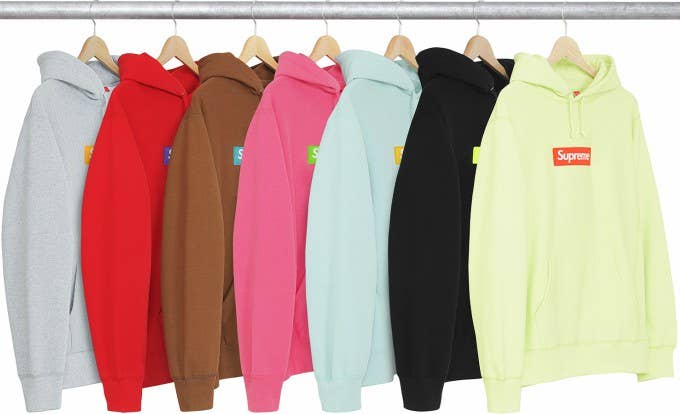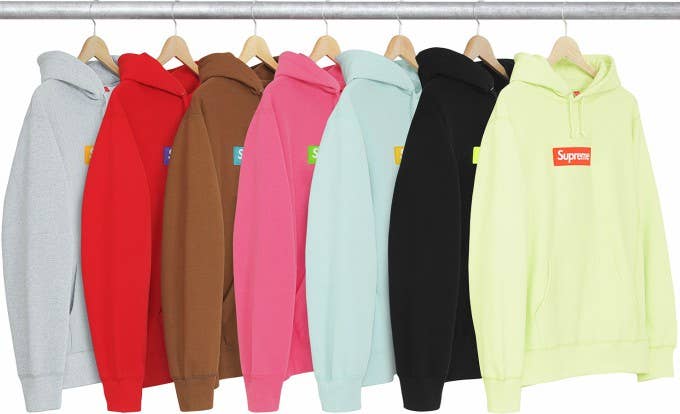
This past Monday VF Corporation acquired Supreme for $2.1 billion and the reactions have been mixed.
The comments under Complex Style’s IG post about the news range from “It’s gonna be a win for the industry, but an L for resellers,” to “Yea, they over with for sure.” Long-time Supreme collector and content creator Eric Whiteback created an IG post with a Supreme tombstone and a long caption outlining all the ways in which he thinks Supreme’s declined over the years—despite his page being fully dedicated to the brand. “This sale signifies the yawn-inducing, corporate boredom of a brand that was originally destined to be something different,” writes Whiteback.
This type of “Supreme is Dead” chatter comes up each time the brand makes a big move, whether it be collaborating with Louis Vuitton or receiving investment from the Carlyle Group back in 2017, but this deal is different. Another company now owns 100 percent of Supreme. And although James Jebbia will remain on staff and VF Corp. says it will let him do his thing, one can’t help but question how Supreme will fare when it's no longer completely under Jebbia’s tight control. VF Corp. says it wants to increase sales by eight to 10 percent and essentially get back the $2.1 billion it paid for Supreme—over the past year Supreme made upwards of $500 million in sales.
Will it increase production, making the brand less scarce and less valuable on the resale market? Is the deal good or bad? Does this mean streetwear is dead? Will its prices change? Will it end up in Zumiez or Macy’s and face the same fate as once -oveted streetwear brands like Crooks and Castles, BBC, and BAPE? These are all of the questions floating around this deal.
Augie Galan, one of Supreme’s original designers, remembers working with The North Face, which is owned by VF Corp., on its first Supreme collaboration in 2007. From that experience, and VF Corp.’s reputation with other companies, like Vans, Red Wing, and Timberland, Galan believes it’s a smart move that won’t harm Supreme’s identity.
“The thing about VF Corp. is they allow their companies to operate independently, and that's their business model,” says Galan. “They acquire these companies, but they still allow them to have their own culture and their own sense of identity. I think they just provide really good support, financial backing, and infrastructure.”
Geoff Heath, Supreme’s first hired graphic designer, who used to cull through newsstands, museums, libraries, and bookstores in New York City to hunt down references to turn into graphics, also applauds the deal.
“I think it's a good thing. It will be interesting to see how a streetwear company navigates and operates in the larger corporate world. Supreme has done a good job of maintaining their standing in the world without selling out. I hope they can apply that to the larger world. I think James can do that.”
But how do you grow Supreme to sell billions of dollars’ worth of product without "selling out" or diluting its brand message? Vans is a strong case study. In 2004, VF Corp. purchased the skate brand for $396 million, and from 2008 to 2013 its revenue grew from $750 million to $1.7 billion. VF Corp.’s strategy was to keep price points accessible. Even when luxury brands like Celine and Givenchy were making their own slip-ons, Vans maintained its image as being the affordable original. Within the first two years of the acquisition, VF Corp. identified a new target customer for Vans—“expressive creators”—and began to market it more towards consumers interested in street fashion rather than skateboarding. In 2008, the brand opened its first retail store in Shanghai—its first footprint in the Asian market—and followed that up by opening distribution channels in Mexico and India.
VF could execute a similar strategy with Supreme, which has been able to maintain a cachet as it’s grown post-Carlyle investment—its annual revenue rose from $200 million to over $500 million, and Supreme opened stores in Williamsburg and San Francisco. Supreme collector BK the God says he’s noticed changes since then, but nothing that turned him off from purchasing the brand’s goods.
“For me, Supreme has always kind of been the same. Some stuff is overproduced; other items are extremely limited. I’m constantly surprised by the flux of the stock,” says BK the God, who is anonymous and posts headless or faceless pictures of himself wearing Supreme to his IG page. “More fans means more supply, and that’s necessary as long as they’re trying to create long-term customers like myself. A lot of people preaching against the acquisition are just talking out of their asses. Nobody really knows what Supreme’s grand plan is or how things will play out. I’ve seen Supreme go through plenty of different phases to get to where they are today. I’m excited to see where they’re going.”
Supreme definitely has space to grow. It currently operates 12 stores globally, and over 60 percent of its sales come from digital. International expansion into Asia, where it’s had issues with counterfeit brand Supreme Italia but finally won a legal battle against it and secured a Chinese trademark this past May, presents a huge opportunity. And VF Corp. is focused on direct-to-consumer brands. Susan Scafidi, the founder of Fordham’s Fashion Law Institute, says because of this dynamic, both entities are set to gain something. Scafidi believes VF Corp. will help Supreme increase its global footprint and that Supreme can lend it knowledge on what she describes as its “alchemy of scarcity plus authenticity” that brings people to line up outside its stores during a pandemic.
“This is a big win for Supreme and a huge prize for VF,” says Scafidi. “These companies know one another’s cultures pretty well already from having collaborated and visiting with someone and doing a project together. There’s already a connection there.”
As far as the Supreme consumer is concerned, Scafidi believes for now you don’t have to worry about finding it in TJ Maxx, but it’s a possibility in the future.
“If it can happen to Donna Karan, it can happen to anyone. So of course it's a long term worry. But by the time the guys who are worried about that will see this product in TJ Maxx, they will be middle-aged dads with rug rats of their own. So no need to worry yet,” says Scafidi. “But I think Supreme is very much aware of that concern and very much in touch with its base. They're going to do everything they can to guard against that kind of downmarket slide. Their likely strategy is to continue opening their own brick-and-mortars in new places.”
Vanessa Friedman called Supreme the Chanel of streetwear, but mentioned how Chanel is still independently owned—VF Corp. is a publicly traded company, and after the acquisition of Supreme, its stock went up by more than 11 percent. Chanel has 310 stores worldwide, made $12.3 billion in the 2019 fiscal year, and just launched e-commerce in 2016. Scafidi mentioned Hermès, which someone can purchase at a duty-free shop in any major airport around the world but still commands a waiting list for its Birkin bags. Scafidi believes Supreme could follow a similar model that doesn’t have the same dramatic price differentiation but maintains scarcity for some product categories and expands on others.
But outside of Supreme, the deal could signal what’s considered an American luxury brand in 2020 and beyond. Streetwear has proven to be a high-margin business with sticky consumers and cultural relevance. While Supreme is an anomaly and doesn’t have many peers, it does challenge the idea that streetwear is dead. Yes, customers can grow out of brand, but if relevance is maintained with smart distribution and accessible pricing, it will gain a new set of young customers each year. This could mean the end of luxury and streetwear collaborations, primarily because that market is tapped and streetwear could be viewed as a type of luxury in its own right.
“I do think that what it means is that the money in fashion is changing its focus. Yes, we have LVMH acquiring Tiffany and this kind of consolidation at the luxury level that will continue. But I think that in addition to the large luxury conglomerates, there’s a new sheriff in town, and that is this really dramatic, passionate devotion to brands that are not priced out of reach,” says Scafidi. “We've asked for years, why isn’t there an American LVMH? You know what, maybe there is. But it's not about high-end European artisanal quality. It’s about a certain American spirit that is always a little bit of an outsider spirit. So it’s the new world versus the old.”
